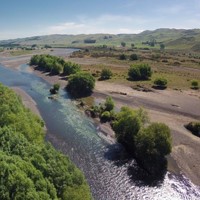
Current filter:

The recent death of a pet dog due to a suspected case of cyanobacterial poisoning at a river, prompts a renewed warning from Hawke’s Bay Regional Council and the Hawke’s Bay District Health Board about the risks of toxic algae in summer. HBRC staff were told the dog was at Tukituki River's Horseshoe Bend off Kahuranaki Road and HBRC environmental science staff are investigating.
“We were saddened to hear of the death of the dog, and our thoughts are with the family who will be missing their pet,” says HBRC Interim Chief Executive, Liz Lambert.
“It is a sad consequence of the warm summer weather when there is always a high likelihood of algal blooms in Hawke’s Bay rivers. Our river areas are popular places to exercise dogs and so we recommend that owners be extra cautious in summer. Keep your dogs under control, perhaps on a retractable leash, and take your own supply of fresh water for them to drink. We want to avoid having any more pets suffer.”
Added information: Keeping pets healthy in summer from NZ Veterinary Association http://www.nzva.org.nz/mediarelease/keeping-pets-safe-over-summer?destination=node%2F4609
Hawke’s Bay Regional Council staff assess the popular recreation sites they monitor each week on the Ngaruroro, Tutaekuri and Tukituki rivers, but cannot check the whole length of rivers. People enjoying the rivers for recreation also need to be aware of the variety of risks and take precautions.
In the height of summer, toxic blue-green algae 'mats' dry out at the side of rivers as the water flows reduce. The toxin forming blue-green algae naturally occur in all rivers, stream and lakes. The warm summer weather coupled with low river flows increases blue-green algal growth, often making water unsafe for swimming and forming the mats. Not all algae is toxic but blue-green algae, known as cyanobacteria, can be, even when dry.
These mats should not be touched, and people should avoid swimming where mats are present. The mats can vary in colour from brown/black when in the water to a pale brown/whitish colour when dry, and are identifiable by a strong musty smell which dogs will naturally want to investigate. More detail on what the mats look like can be found on HBRC’s website www.hbrc.govt.nz under the Quick Links.
Stuart Badger of Hawke’s Bay Vet Services in Hastings warns that dogs are particularly susceptible to the toxins compared to other stock.
“When you go near a river, take fresh water and a bowl so you can give your dog a good drink of water before they run around, so they are less tempted to drink from the river,” he says.
He says the main symptoms are gastro-intestinal, such as vomiting and diarrhoea with blood, or neurological, such as inability of the dog to use their back legs and shaking, although both ranges of symptons can occur. Any dogs or other animals that appear unwell or are sick after being in or alongside a river should get prompt veterinary attention.
Hawke’s Bay District Health Board Public Health Specialist Rachel Eyre says people who come into contact with the toxic form of the mat may experience vomiting, diarrhoea, skin rashes and numbness or tingling around the mouth. Children are particularly at risk. Anyone displaying signs of illness after being in a river bed should seek medical advice from a doctor immediately.
The HBDHB Public Health Unit should be alerted in the event of health issues occurring after contact with river or lake water. The On Call Health Protection Officer can be contacted on 06 834 1815.
6 April 2016
Disclaimers and Copyright
While every endeavour has been taken by the Hawke's Bay Regional Council to ensure that the information on this website is
accurate and up to date, Hawke's Bay Regional Council shall not be liable for any loss suffered through the use, directly or indirectly, of information on this website. Information contained has been assembled in good faith.
Some of the information available in this site is from the New Zealand Public domain and supplied by relevant
government agencies. Hawke's Bay Regional Council cannot accept any liability for its accuracy or content.
Portions of the information and material on this site, including data, pages, documents, online
graphics and images are protected by copyright, unless specifically notified to the contrary. Externally sourced
information or material is copyright to the respective provider.
© Hawke's Bay Regional Council - www.hbrc.govt.nz / +64 6 835 9200 / info@hbrc.govt.nz